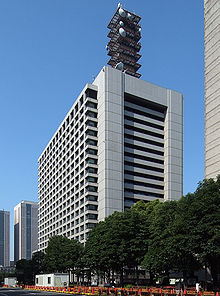National Police Agency (Japan)
| National Police Agency Keisatsu-chō | |
|---|---|
 | |
 The Kyokujitsushou | |
| Abbreviation | NPA |
| Agency overview | |
| Formed | July 1, 1954 |
| Preceding agency |
|
| Employees | 7,995 (2020)[1] |
| Annual budget | ¥360.348 billion (2020)[2] |
| Legal personality | Law enforcement agency |
| Jurisdictional structure | |
| National agency | Japan |
| Operations jurisdiction | Japan |
| Operational structure | |
| Headquarters | 2-1-2 Kasumigaseki, Chiyoda, Tokyo 100-8974, Japan |
| Civilians | 4,800 |
| Agency executive |
|
| Parent agency | National Public Safety Commission |
| Child agencies |
|
| Bureaus | 5
|
| Regional Bureaus | 6
|
| Website | |
| www.npa.go.jp/english/index.html (in English) www.npa.go.jp (in Japanese) | |
| [3] | |

The National Police Agency (
As of 2017, the NPA has a strength of approximately 7,800 personnel: 2,100 sworn officers, 900 guards, and 4,800 civilian staff.[5]
History[edit]
Police services of the Empire of Japan were placed under complete centralized control with the Police Affairs Bureau (警保
During the occupation, the principle of decentralization was introduced by the 1947 Police Law. Cities and large towns had their own municipal police services (
As a response to these problems, complete restructuring created a more centralized system under the 1954 amended Police Law. All operational units except for the Imperial Guard were reorganized into prefectural police for each prefecture, and the National Police Agency was established as the central coordinating agency for these Police Departments.[6]
On April 1, 2022, the NPA created the Cyber Affairs Bureau and the National Cyber Unit.[7] On December 2023, the NPA announced that the TAIT (Telecom Scam Allianced Investigation Team) will be established on April 2024 to unify investigation efforts across Japan on fraud cases.[8]
Organization[edit]
Leadership[edit]
The Commissioner General of the National Police Agency (
Internal Bureaus[9][edit]
Community Safety Bureau[edit]
The Community Safety Bureau (
This bureau was derived from the Safety Division of the Criminal Affairs Bureau in 1994.[11]
- Community Safety Planning Division (
生活 安全 企画 課 ) - Personal Safety and Juvenile Division (
人身 安全 ・少年 課 ) - Safety Division (
保安 課 ) - Director for Economic Crimes Investigation (
生活 経済 対策 管理 官 )
Criminal Affairs Bureau[edit]
The Criminal Affairs Bureau (
- (Direct reporting divisions)
- Criminal Affairs Planning Division (
刑事 企画 課 ) - First Investigation Division (
捜査 第 一 課 ) - Second Investigation Division (
捜査 第 二 課 ) - Director for Criminal Intelligence Support (
捜査 支援 分析 管理 官 ) - Director for Criminal Identification (
犯罪 鑑識 官 )
- Criminal Affairs Planning Division (
- Organized Crime Department (
組織 犯罪 対策 部 )- First Organized Crime Division (
組織 犯罪 対策 第 一 課 ) - Second Organized Crime Division (
組織 犯罪 対策 第 二 課 ) - Director for International Investigative Operations (
国際 捜査 管理 官 )
- First Organized Crime Division (
Traffic Bureau[edit]
The Traffic Bureau (
- Traffic Planning Division (
交通 企画 課 ) - Traffic Enforcement Division (
交通 指導 課 ) - Traffic Management and Control Division (
交通 規制 課 ) - License Division (
運転 免許 課 )
Security Bureau[edit]
The Security Bureau (
- (Direct reporting divisions)
- Security Planning Division (
警備 企画 課 ) - Public Security Division (
公安 課 )
- Security Planning Division (
- Foreign Affairs and Intelligence Department (
外事 情報 部 )- Foreign Affairs Division (
外事 課 ) - Counter International Terrorism Division (
国際 テロリズム対策 課 )
- Foreign Affairs Division (
- Security Operations Department (
警備 運用 部 )- 1st Security Operations Division (
警備 第 一 課 ) - 2nd Security Operations Division (
警備 第 二 課 ) - 3rd Security Operations Division (
警備 第 三 課 )
- 1st Security Operations Division (
After the 1996 Japanese embassy hostage crisis in Peru, the Security Bureau established the Terrorism Response Team where officers liaise with foreign law enforcement and intelligence agencies when Japanese interests or nationals are in danger.[12] It was later reformed to the Terrorism Response Team - Tactical Wing (TRT-2) for Overseas in order to meet with demands to coordinate with foreign police forces in assisting them whenever a terror attack has happened.[12]
Cyber Affairs bureau[edit]
The Cyber Affairs bureau (サイバー
- Cyber-Policy Planning Division (サイバー
企画 課 ) - Cybercrime Investigation Division (サイバー
捜査 課 ) - Digital Analysis Division (
情報 技術 解析 課 )
Local Branch Bureaus and Departments[edit]
Regional Police Bureaus[edit]
There are six Regional Police Bureaus (
- Tōhoku Regional Police Bureau (
東北 管区 警察 局 , Tōhoku Kanku Keisatsu-kyoku) - Aomori, Iwate, Miyagi, Akita, Yamagata, and Fukushima Prefectures
- Kantō Regional Police Bureau (
関東 管区 警察 局 , Kantō Kanku Keisatsu-kyoku) - Ibaraki, Tochigi, Gunma, Saitama, Chiba, Kanagawa, Niigata, Yamanashi, Nagano, and Shizuoka Prefectures
- Chūbu Regional Police Bureau (
中部 管区 警察 局 , Chūbu Kanku Keisatsu-kyoku) - Toyama, Ishikawa, Fukui, Gifu, Aichi, and Mie Prefectures
- Kinki Regional Police Bureau (
近畿 管区 警察 局 , Kinki Kanku Keisatsu-kyoku) - Shiga, Kyoto, Osaka, Hyogo, Nara, and Wakayama Prefectures
- Chūgoku–Shikoku Regional Police Bureau (
中国 四国 管区 警察 局 , Chūgoku Shikoku Kanku Keisatsu-kyoku) - Tottori, Shimane, Okayama, Hiroshima, and Yamaguchi Prefectures
- Tokushima, Kagawa, Ehime, and Kochi Prefectures
- Kyūshū Regional Police Bureau (
九州 管区 警察 局 , Kyūshū Kanku Keisatsu-kyoku) - Fukuoka, Saga, Nagasaki, Kumamoto, Oita, Miyazaki, Kagoshima, and Okinawa Prefectures
They are located in major cities of each geographic region. The Tokyo Metropolitan Police Department and Hokkaido Prefectural Police Headquarters are excluded from the jurisdiction of regional police bureaus. Headed by a Senior Commissioner, each regional police bureaus exercises necessary control and supervision over and provides support services to prefectural police within its jurisdiction, under the authority and orders of NPA's Commissioner General. Attached to each Regional Police Bureaus is a Regional Police School which provides police personnel with education and training required of staff officers as well as other necessary education and training.
Police Communications Departments[edit]
Metropolitan Tokyo and the island of Hokkaidō are excluded from the regional jurisdictions and are run more autonomously than other local forces, in the case of Tokyo, because of its special urban situation, and of Hokkaidō, because of its distinctive geography. The National Police Agency maintains police communications divisions in these two areas to handle any coordination needed between national and local forces. In other area, Police Communications Departments are established within each Regional Police Bureaus.
- Independent Communications Departments
- Tokyo Metropolitan Police Info-Communications Department (
東京 都 警察 情報 通信 部 , Tōkyō-to Keisatsu Jōhō Tsūshin-bu) - Hokkaido Police Info-Communications Department (
北海道 警察 通信 情報 部 , Hokkaidō Keisatsu Tsūshin Jōhō-bu)
- Tokyo Metropolitan Police Info-Communications Department (
Subsidiary Organs[edit]
- National Police Academy (
警察 大 学校 , Keisatsu Dai-gakkō) - National Research Institute of Police Science (
科学警察研究所 , Kagaku Keisatsu Kenkyū-sho) - Imperial Guard Headquarters (
皇宮警察 本部 , Kōgū-Keisatsu Honbu)
See also[edit]
- Police services of the Empire of Japan
- Law enforcement in Japan
- Public order and internal security in Japan
- Fire and Disaster Management Agency
References[edit]
- ^
行政 機関 職員 定員 令 (昭和 44年 5月 16日 政令 第 121号 )(最終 改正 、令 和 2年 3月 30日 政令 第 75号 ) - e-Gov法令 検索 - ^
令 和 2年度 一般 会計 予算 財務省 - ^ "Police of Japan". National Police Agency. Archived from the original on 2008-02-22. Retrieved 2008-08-06.
- ^ Police of Japan, National Police Agency. "POLICE OF JAPAN - NATIONAL POLICE AGENCY | Office of Justice Programs". www.ojp.gov. Retrieved 19 May 2022.
- ^ National Police Agency (2018). POLICE OF JAPAN 2018 (Overview of Japanese Police) (PDF) (Report). Archived (PDF) from the original on 2019-04-07. Retrieved 2019-04-07.
- ^ a b c d e f National Police Agency Police History Compilation Committee, ed. (1977). Japan post-war police history (in Japanese). Japan Police Support Association.
- ^ "Japan makes progress on international cyber probe collaboration". 4 September 2023.
- ^ "Police to Set up Special Fraud Investigation Team". 14 December 2023.
- ^ NPA. "Organization Chart". Retrieved 2024-04-28.
- ^ a b c d National Police Agency. "Mechanism of Police systems" (in Japanese). Archived from the original on 2012-12-06. Retrieved 2016-11-07.
- ^ Japan Federation of Bar Associations. "Declaration on police activities and citizens' human rights" (in Japanese). Archived from the original on 2016-11-15. Retrieved 2016-11-08.
- ^ a b "Archived copy" (PDF). Archived (PDF) from the original on 2011-03-23. Retrieved 2011-03-26.
{{cite web}}: CS1 maint: archived copy as title (link) - ^ Asahi Shinbun news papre. "NPA to create new bureau for cybersecurity threats". Retrieved 2024-04-28.
- ^ "Public Safety Commission System and Police Activity Support" (PDF). Japanese National Police Agency. Archived from the original (PDF) on 2012-04-20. Retrieved 2012-02-15.
External links[edit]
- Official website (in Japanese)
- Official website (in English)
- National Police Agency on Twitter
